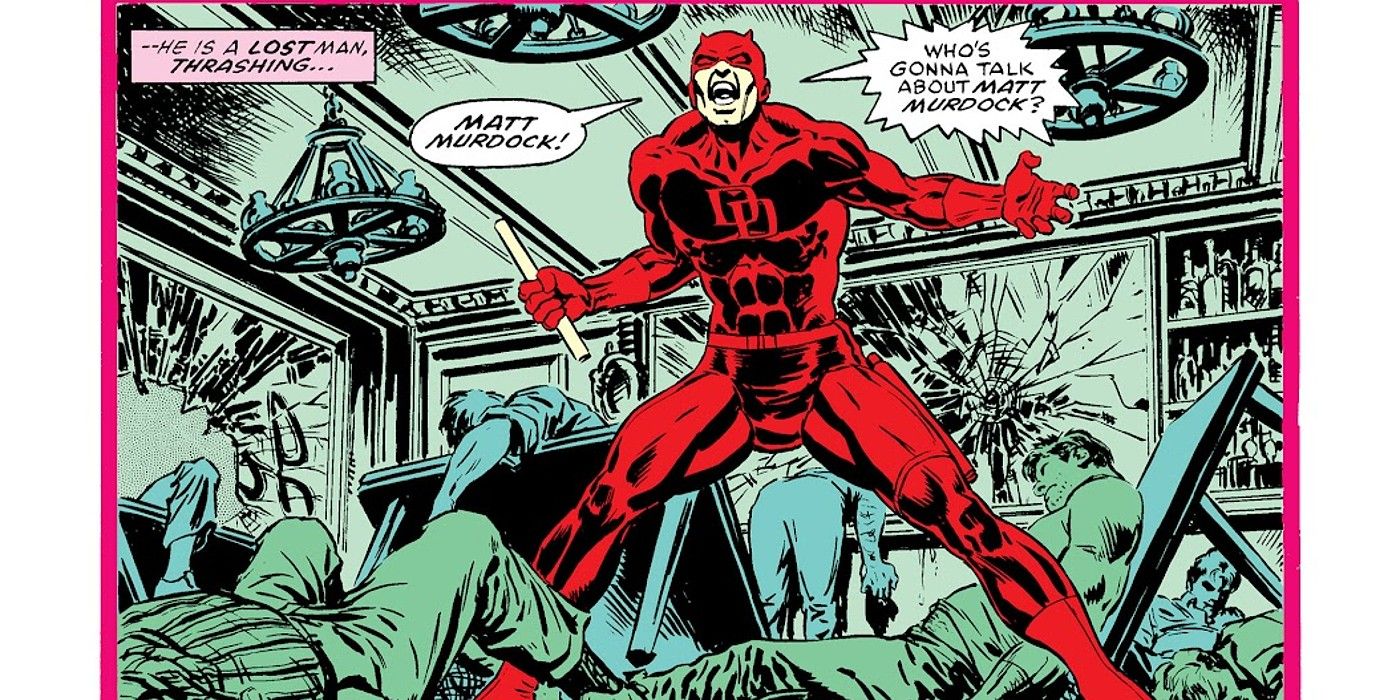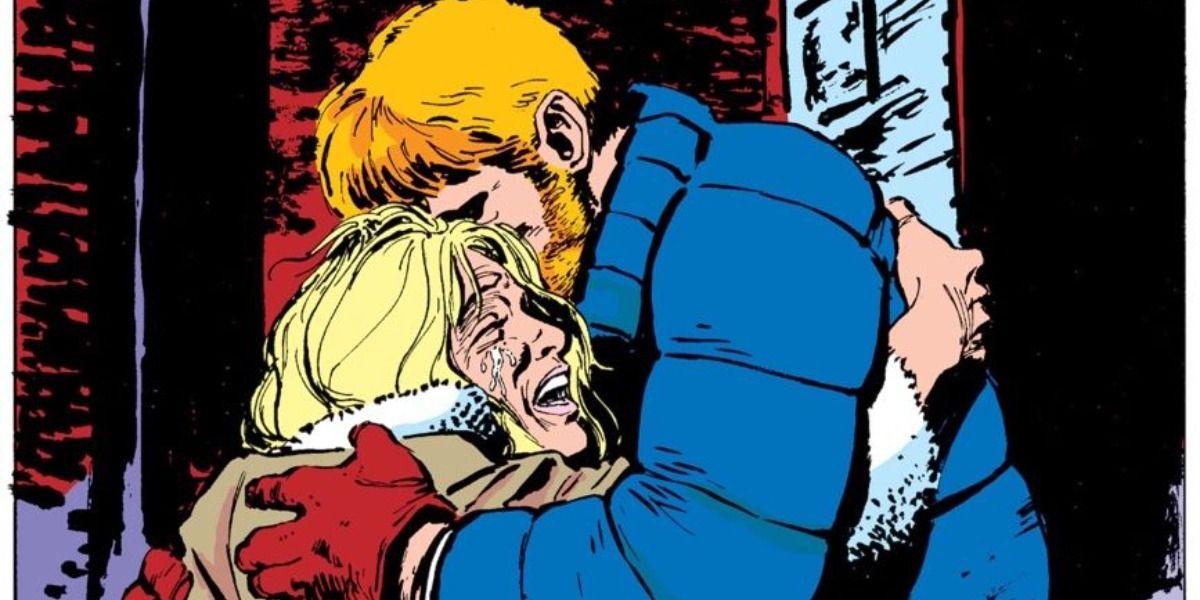When compiling the greatest comic stories of all time, there’s obviously a lot to choose from, but of all the nooks and crannies within comic-dom there’s a reason why Frank Miller‘s somewhat obscure Daredevil: Born Again is almost always included in any experienced aficionado’s list without fail. A simple, yet powerful character-driven parable of a hero who finds himself exposed to the slings and arrows of outrageous fortune, Born Again is a story which, alone among Marvel’s myriad musings of the late ‘80s, might indeed have signaled the change that many would go on to describe as the maturation of the medium.
No stranger to grim and gritty, the irrepressible Frank Miller teamed up with David Mazzucchelli in early 1986 on Daredevil, the brief run itself being a return by Miller to the title he had brought to prominence only four years earlier. Written concurrently with his other milestone work of the period, The Dark Knight Returns, Born Again was vastly different from Miller’s preceding run, and in fact was unlike most of the previous offerings by Marvel up to that point.
What separated Born Again was a certain touch of realism to the melodrama that saw DD’s alter ego Matt Murdock plunge into a living nightmare brought about by the revelation of his secret identity to his arch nemesis Wilson Fisk aka Kingpin. Summoning a shade of forlorn poetry to his writing later honed further in his blockbuster hit Sin City, Miller managed to strike a rare tone of artistry within the usually colorful world of Marvel that proved a harbinger of things to come. And, quite surprisingly for him, Miller did it with nuance
A Devil In Despair

Daredevil: Born Again begins in rather auspicious fashion in issue #227, with Matt Murdock’s former secretary/love interest Karen Page revealed to have descended into prostitution and drug addiction following her previous Hollywood foray into acting. Selling Daredevil’s identity in exchange for drugs, the information leads Kingpin to incite a campaign of surreptitious smears, destruction and financial sabotage, gradually causing Matt to lose his home, professional reputation, legal license and sanity, as he is reduced to an unhinged, homeless, violent madman. Nearly killed by Fisk in a brawl when he attempts to confront him, the second half of the story-arc features Murdock’s redemption as he resumes his heroics as Daredevil in the midst of Fisk’s ever escalating campaign to destroy him.
The arc marks a certain peak in Miller’s traditional-style comic writing which, while informing his more experimental and bombastic stories like 300, would never quite recapture the spirit of earnestness that ultimately remains the touchstone of Born Again. The close characterization of the superhero Daredevil as at heart a fragile man whose existence is being slowly throttled by his foremost enemy on a whim, and who must then summon his heroism when he slowly climbs out of that hell, is among Miller’s most compelling stories. That Miller does it with such effortless grace while still maintaining the slightly hokey, over-the-top schlock he’d made his trademark on the title, including a cold, yet seething glimpse into Fisk’s inner workings, is perhaps one of the great balancing acts in the history of mainstream comics.
Marvel had already delved into lasting tragedy in its titles. Gwen Stacy died in The Amazing Spider-Man #121 published in 1973, followed by Captain Marvel in 1982’s The Death of Captain Marvel, but Miller’s stories had always involved a more street-level perspective. This more everyday realism served to heighten the quite brutal gauntlet Daredevil stares down throughout Fisk’s campaign. At one point stabbed and left for dead on the street by low-level brigand Turk, Murdock’s suffering, and ultimate triumph, is set against a backdrop of societal cruelty, as, despite his lifetime of good deeds, Daredevil is attacked on all sides. Besieged by demons both imagined and real, most hair-raisingly when Fisk arranges for a psychopathic serial killer to be released and sent to kill Page and his partner Foggy Nelson while dressed in a Daredevil costume, Murdock’s journey is often simply a battle for survival. It is this quality that grants it such lasting influence.
How Daredevil Helped Comics Grow Up

Born Again was released during a period of transition in the comics industry, and, while other works would become better known examples of the trend, is a core part of what would become the “maturation” process of the medium. Despite abandoning the self-imposed censorship of the Comics Code in the early 1970s, there were still only a few examples of mature elements, such as sex, drugs and psychological realism, being used to their full extent. What Miller and Mazzucchelli delivered was not a simple brand of exploitation, nor life-changing plot twists for the sake of spectacle, but a harrowing view tinged with snaking realism into what a villain like Fisk could accomplish if given anonymous rein to destroy the life of the hero. Set amidst stark, brutalist cityscapes and dank, putrid alleys, Born Again methodically removed the trappings of Matt Murdock’s heroism to reveal a world that, populated with costumed heroes though it may be, had failed to prevent the systematic, government aided abuse of one of their own.
The story culminates in issue #233 as Daredevil, having only just resumed the mantle, must tangle with a drug-addled, experimentally built super soldier with a tattoo of the American flag on his face: Nuke. A symbol of the false protection Murdock previously believed he enjoyed as a costumed hero, Nuke is sent to Hell’s Kitchen on loan to Fisk in commission of the destruction of the neighborhood in order to draw the hiding Daredevil out. The ensuing battle, which only ends when the Captain America-led Avengers arrive, is among the most viscerally wrought sequences in traditional superhero comics, showcasing in riveting flourish the true cost of Fisk’s need for retribution in stark relief to the real-life hardships imposed by America’s military adventurism of the period.
Born Again is the rare story that continues to be compelling, even three and a half decades after its release, not due to how it bucks the trends of its genre, but by how it embraces them, in some ways reconstructs them. Page, quite unlike the glamorous Lois Lane she is based upon, is a disgraced pornographic actress who sells out the man who saved her life multiple times for heroin. Murdock, unlike the suave Batman he mirrors, sees his home blown to pieces and himself thrown out on the street in the midst of a paranoia-fueled nervous breakdown he can do nothing to stop and which ends up almost killing him. And yet, even with the darkness these characters endure, in the end there is hope. Matt forgives Karen, and the story ends with them together again.
What Daredevil: Born Again managed to accomplish was a feat of chemistry in some regard: grim and gritty though it may have been, the focus on characters throughout, and the lack of clear levity for the beleaguered protagonists of this benighted New York City (most notably in the hard luck Daily Bugle reporter Ben Urich) allowed the title to shine in all its hard-boiled noir glory while offering a decent taste of superhero action. And that is how, with a dash of poetry and a flair for moody cityscapes, Frank Miller‘s Daredevil: Born Again ended up setting the template for how Marvel Comics would mature.




